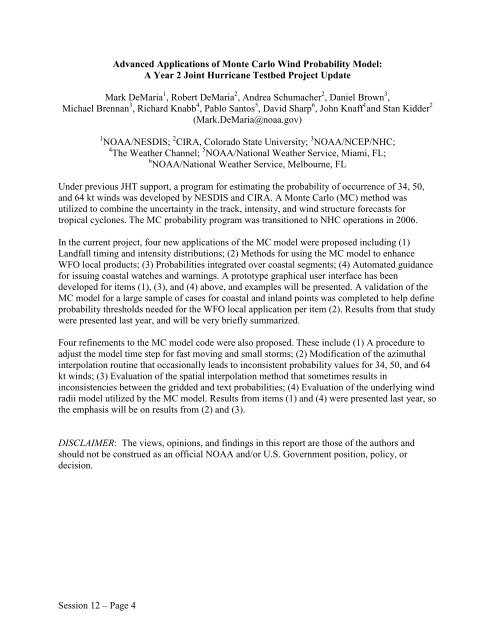65th IHC Booklet/Program (pdf - 4.9MB) - Office of the Federal ...
65th IHC Booklet/Program (pdf - 4.9MB) - Office of the Federal ...
65th IHC Booklet/Program (pdf - 4.9MB) - Office of the Federal ...
Create successful ePaper yourself
Turn your PDF publications into a flip-book with our unique Google optimized e-Paper software.
Advanced Applications <strong>of</strong> Monte Carlo Wind Probability Model:<br />
A Year 2 Joint Hurricane Testbed Project Update<br />
Mark DeMaria 1 , Robert DeMaria 2 , Andrea Schumacher 2 , Daniel Brown 3 ,<br />
Michael Brennan 3 , Richard Knabb 4 , Pablo Santos 5 , David Sharp 6 , John Knaff 1 and Stan Kidder 2<br />
(Mark.DeMaria@noaa.gov)<br />
1 NOAA/NESDIS; 2 CIRA, Colorado State University; 3 NOAA/NCEP/NHC;<br />
4 The Wea<strong>the</strong>r Channel; 5 NOAA/National Wea<strong>the</strong>r Service, Miami, FL;<br />
6 NOAA/National Wea<strong>the</strong>r Service, Melbourne, FL<br />
Under previous JHT support, a program for estimating <strong>the</strong> probability <strong>of</strong> occurrence <strong>of</strong> 34, 50,<br />
and 64 kt winds was developed by NESDIS and CIRA. A Monte Carlo (MC) method was<br />
utilized to combine <strong>the</strong> uncertainty in <strong>the</strong> track, intensity, and wind structure forecasts for<br />
tropical cyclones. The MC probability program was transitioned to NHC operations in 2006.<br />
In <strong>the</strong> current project, four new applications <strong>of</strong> <strong>the</strong> MC model were proposed including (1)<br />
Landfall timing and intensity distributions; (2) Methods for using <strong>the</strong> MC model to enhance<br />
WFO local products; (3) Probabilities integrated over coastal segments; (4) Automated guidance<br />
for issuing coastal watches and warnings. A prototype graphical user interface has been<br />
developed for items (1), (3), and (4) above, and examples will be presented. A validation <strong>of</strong> <strong>the</strong><br />
MC model for a large sample <strong>of</strong> cases for coastal and inland points was completed to help define<br />
probability thresholds needed for <strong>the</strong> WFO local application per item (2). Results from that study<br />
were presented last year, and will be very briefly summarized.<br />
Four refinements to <strong>the</strong> MC model code were also proposed. These include (1) A procedure to<br />
adjust <strong>the</strong> model time step for fast moving and small storms; (2) Modification <strong>of</strong> <strong>the</strong> azimuthal<br />
interpolation routine that occasionally leads to inconsistent probability values for 34, 50, and 64<br />
kt winds; (3) Evaluation <strong>of</strong> <strong>the</strong> spatial interpolation method that sometimes results in<br />
inconsistencies between <strong>the</strong> gridded and text probabilities; (4) Evaluation <strong>of</strong> <strong>the</strong> underlying wind<br />
radii model utilized by <strong>the</strong> MC model. Results from items (1) and (4) were presented last year, so<br />
<strong>the</strong> emphasis will be on results from (2) and (3).<br />
DISCLAIMER: The views, opinions, and findings in this report are those <strong>of</strong> <strong>the</strong> authors and<br />
should not be construed as an <strong>of</strong>ficial NOAA and/or U.S. Government position, policy, or<br />
decision.<br />
Session 12 – Page 4
















